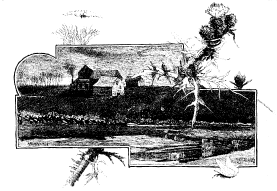

© Copyright 1996, 1997, 1998 by Diane Haugen. All rights reserved
This book tells the story about my uncle, Dale Goldsmith, and his lifelong relationship to a land that many see as worthless. As you look at the pictures in this book, you may notice there is nothing but grassy, relatively flat land in the background, even though the horizon may be several miles away. The short grass prairie is a vast sea of what looks to outsiders to be decidedly empty space. For those who love this land, however, there is much to "see." That seeing, though, takes a careful eye, a quiet introspection, a strength to look within and see the common thread that ties us all to the landscape without.
Dale was born and raised and lived all but the last two and a half years of his life on the homestead his father had filed a claim for in 1903. He was of the generation that kept everything. There are those who theorize that this comes from living through the Depression, when people had to make do with what they had. Everything was saved, from pieces of paper to used string, because it might be needed some day. But I tend to think this answer is far too easy, far too obvious. People of my uncle's generation had what I can only call a fine sense of history, something that we as a society have seemed to have lost.
After my uncle's death, as I went through his belongings, I thought often of the many probabilities the living of his life offered, a life many might believe was terribly constrained by a stark reality. But the boxes of things he chose to save reflect a man who may have had little of what today's society values, but a man rich in a knowledge of where he came from and where he was going.
For a good part of his life, the land he loved had little value. For many years banks wouldn't loan money to farmers against it and no one would buy it. In time, bankers who had foreclosed on nearby land would come to visit Dale in his home and try to convince him to buy the land they were stuck with. Sometimes he would oblige, but often he would not. The memories of his parents' struggle to pay the taxes on their homestead were too strong. A few years before he died, he was asked what he would have done differently if he had had his life to live over. His answer: "Buy more land."

My uncle never married and had no children of his own. I had spend several years on the farm as a youngster and several summers when I was in high school. I returned several summers when he was in his 70s and tape recorded many hours of conversation with him. And in the end, I cared for him in my home for the two and a half years before he died at the age of 86 from Parkinson's and kidney failure.
As I searched through storage areas and opened box after box of things Dale saved, I began to realize that he had kept everything, not just selected items as mementos. He kept absolutely everything. There were chattel mortgages for cattle during the 1910s and 1920s, birth announcements from before Dale was born in 1907, postcards and valentines his aunts had written to him when he was a only a few years old, an empty package of cabbage and tomato seed, a Franco radio battery box with what looks like popcorn seed inside, and a Piso's Pocket Almanac for 1909 about the size of a Cracker Jack prize.
Some of these things I had been shown before. Many of them I had not. As I sorted through Dale's things, I began to see a side of my uncle that he had never revealed to me, even though I had spent numerous hours talking with him about life on the short grass prairie as he was growing up. As I looked over the collection of things Dale had saved, I was struck by how we are losing the texture of our lives in our throwaway society, where the record of our pasts are being destroyed by trips to the landfill, where far too many of us consider anything new preferable to anything old, and few people bother to save the kinds of things that mark the stages of our lives.
This book weaves the many threads of the uncle I knew with the many artifacts he left behind and my childhood memories of life on the homestead. As well as I thought I had known him, the many papers and momentos he saved revealed a depth to what appeared a simple, austere life that we as a culture are fast loosing the ability to even comprehend.
manuscript length: 212 pages
© Copyright 1996, 1997, 1998 by Diane Haugen. All rights reserved. No portion of this chapter may be copied, retransmitted, reposted, duplicated or otherwise used without the express written approval of the author.
 Buffalo Bones and Hauling Bundles
Buffalo Bones and Hauling Bundles
Whiskey Creek Document Design's Home Page
© Copyright 1996, 1997, 1998 Whiskey Creek Document Design. All rights reserved